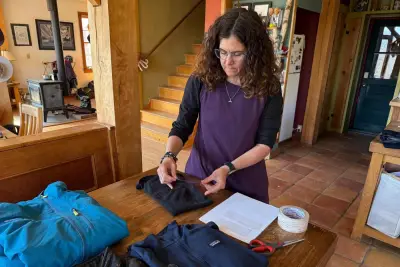Your clothes are shedding bits of plastic. Here’s what people are doing about it this Earth Day

By JENNIFER McDERMOTT Associated Press Bottles and bags food wrappers and straws Piping packaging toys and trays Plastic is everywhere and yet several people may be surprised at how much they in fact wear A typical closet is loaded with plastic woven into polyester activewear acrylic sweaters nylon swimsuits and stretchy socks and it s shedding into the surroundings nonstop When garments are worn washed and put through the dryer they shed plastic fiber fragments A single load of laundry can release millions that are so tiny wastewater restoration plants can t capture them all They wind up in local waterways that connect to the ocean Marine animals eat them and that can pass plastic to larger animals and humans Even natural fabrics shed fibers and have chemicals that can leach into the milieu But polyester is the largest part widely used fiber on Earth and along with other synthetic fibers accounts for about two-thirds of production worldwide Rachael Z Miller founder of the Vermont-based Rozalia Project for a Clean Ocean conducts a tape test on various clothing items to compare how much each material sheds microfibers on Thursday April in Granville Vt AP Photo Amanda Swinhart Tuesday is Earth Day when people worldwide contemplate solutions to reduce their impact on the planet Everyone who wears and launders clothing is part of this matter but everyone who wears and launders clothing can be part of the solutions reported Rachael Z Miller founder of Vermont-based Rozalia Project for a Clean Ocean Simple changes like washing clothes less and using cold water instead of hot can help reduce the shedding of fibers More challenging is that textiles need to be produced and used in a more sustainable way noted Elisa Tonda at the UN Circumstances Programme For example designing clothes that shed fewer microfibers and are high-quality to last longer revealed Tonda who leads the tools and markets branch What to do Start by changing habits The easiest approach is to wash clothes less often making for less of the friction that breaks fibers apart announced Anja Brandon director of plastics plan at Ocean Conservancy They get tumbled and tossed around with a bunch of soaps really designed to shake things up to get out dirt and stains Brandon commented Miller uses a stain stick to spot-clean Both say that when clothes are washed they shed less when put in cold water in full loads to reduce friction on a shorter cycle then hung to dry Inspired by the way coral filters the ocean Miller invented the Cora Ball a laundry ball that can be tossed into the washer to cut down on clothes banging into each other It also catches microfibers A portion of the proceeds goes to the Rozalia Project Another option is to put synthetic fabrics in a washing bag that captures fibers Rachael Z Miller founder of the Vermont-based Rozalia Project for a Clean Ocean tosses a Cora Ball a laundry ball that can be tossed into the washer to cut down on clothes banging into each other on Thursday April in Granville Vt AP Photo Amanda Swinhart Which clothes shed the the greater part To find out press a strip of clear packing tape to a garment then stick it to white paper to check for fibers Miller explained Garments that are loosely knit or woven tend to shed more such as fleece Miller revealed people don t need to rush to throw out clothing that s more likely to shed She owns fleece jackets herself Instead she suggested such clothing can be worn indoors only or outside with a layer on top and it s worth thinking twice about acquiring more garments like that I try not to guilt or panic people because a lot of this information is very new Miller noted And so we might as well just say OK I got it How can I be strategic about what I ve got A push to require filters Filters can be added to washers to capture microfibers Samsung Electronics collaborated with Patagonia and the global conservation organization Ocean Wise to launch one in It s now sold in more than countries for front-load washers Bosch lately launched a microfiber filter in Europe for washers France was first to adopt a law to mandate that new washing machines sold in the country have a microfiber filter though implementation has been delayed In the U S efforts to mandate filters in states have failed California Gov Gavin Newsom vetoed a bill in saying he was concerned about the cost to consumers and he wants to incentivize not mandate technologies to remove microfibers in wastewater In Oregon state Sen Deb Patterson proposed a bill this year requiring microfiber filters on new washers sold in that state after she came across the machinery in Canada Patterson explained the bill doesn t have enough endorsement yet but she ll keep trying The Association of Home Appliance Manufacturers opposes the proposals saying it s concerned about consumer costs and filter effectiveness Changing textiles Particular big brands are testing their fabrics to help researchers understand fiber fragmentation including Adidas Nike Patagonia and Under Armour Related Articles Delta plane catches fire at Orlando airport forcing patron evacuations Puerto Rico ruling body demands answers from Luma after island-wide blackout Survivors of Florida school shootings demand governor reject law lowering gun purchasing age Advanced cancers back at prepandemic levels despite delay in screenings Abortions are resuming at a Wyoming clinic after judge suspends laws They re among more than brands retailers and manufacturers to partner with The Microfibre Consortium in the United Kingdom founded in to do research and offer solutions to transform textile production including reducing fiber breakup Nearly fabrics have been tested None are the same making it a tough concern to solve consortium CEO Kelly Sheridan revealed Patagonia has been a leader in trying to stop the spread of synthetic fiber waste into air and water saying it s up to garment brands to prevent it at the source since cleaning up microplastics in the milieu is not yet viable It paid for its own research starting a decade ago on the implication of its clothes The company worked with suppliers to choose fabrics and dyes and to finish their clothing in methods that reduce shedding They collaborated on new filtration technologies for washers textile mills and municipal systems One of their best-known styles is something called the better sweater that shifts from virgin polyester to recycled polyester to cut shedding by about reported Matt Dwyer vice president of global product footprint And at textile mills there s a prewash at the factory that can capture that first big shed he added Dwyer is optimistic about progress There s a whole lot of smart people not just understanding the matter and the scope of the dilemma but also looking for solutions all the way through the manufacturing cycle and use phase he announced Compared to years ago it s a whole new world The Associated Press circumstances and environmental coverage receives financial promotion from multiple private foundations AP is solely responsible for all content Find AP s standards for working with philanthropies a list of supporters and funded coverage areas at AP org

